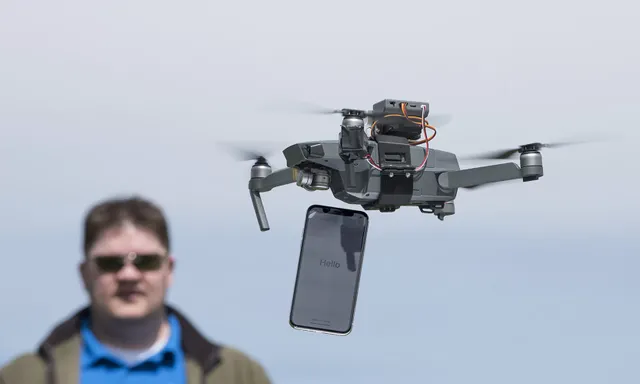How Can a Smartphone Survive a 100-Foot Drop But Crack on Your Floor?
A few weeks ago, I pulled my iPhone out of my purse only to discover a spiderweb of cracks emanating from the earpiece area of the screen. I couldn't remember dropping the phone or hitting my purse against anything, but I must have jostled something just wrong. Considering that last year a guy dropped his phone 1,000 feet (305 meters) out of an actual airplane with no ill effects, my cracked screen feels a little unfair.
But Live Science's sister site Tom's Guide, which reviews tech gadgets, recently did some testing that reveals that phone breakage isn't just about the length of the fall. Tom's Guide testers found that a phone dropped from 100 feet (30 m) might survive the fall, while the same kind of phone might shatter from a 6-foot (1.8 m) drop.
Why? The surface involved in the impact matters, of course, but so does the angle of the fall. And that, says glass expert Peter Houk, is all due to the unique atomic structure of glass.
Strengthening glass
The testing at Tom's Guide lacked the kind of tech you'd need to really test the integrity of smartphone glass, like high-speed cameras and hundreds of spare phones to test. But the Tom's Guide testers found that dropping phones onto plywood, even from a drone flying 100 feet up, didn't necessarily cause the devices to shatter. The drop destroyed some phones, like the Apple iPhone X and the LG V30. Others, like the Samsung Galaxy S9, had no damage whatsoever. (Concrete, unsurprisingly, was far rougher on phones than plywood was, totally killing 10 percent of them when they were dropped from 6 feet onto their edges and 5 percent of them when they were dropped from 6 feet onto their faces.)It's not surprising that there would be variations in breakage, Houk said, given the importance of the angle of contact with the ground.
Here's why: Glass stands up well to compressional forces, or forces that squeeze, said Houk, the director of the Massachusetts Institute of Technology Glass Lab. That's why a phone dropped flat on its face often survives. But "glass doesn't like tension," Houk said. Bend a piece of glass, or apply a small, pinpoint force to one of its edges, and you're likely to end up with a shower of shards.
Smartphone glass and glass used in car windows, shower doors and other places where you don't want a million razor-sharp shards is tempered, but the two types of glass are tempered in very different ways. Window glass is heat-tempered, Houk told Live Science. In thermal tempering, manufacturers heat the glass to 1,148 degrees Fahrenheit (620 degrees Celsius) and then rapidly cool it. The outside and inside of the glass cool at slightly different rates, Houk said, which compresses the surface of the material while putting the interior layer in tension.
For the purposes of strength, this is great — it's very difficult to break the glass by hitting it on its face, because the additional compression further strengthens the glass against forces that compact it. When it does break, the high compressive force gets released all at once, causing the glass to break into tiny, pebble-like pieces rather than large, knifelike shards.
In their screens, smartphone manufacturers tend to favor Gorilla glass, a chemically tempered glass made by the company Corning. This glass makes up iPhones, and Samsung, LG and other phone manufacturers also use it. Gorilla glass is bathed in potassium salts, Houk said, which allows potassium ions (charged molecules of potassium) to squeeze in between the silica atoms in the glass's molecular structure. This is another way of creating a strong, compressive layer.
"It makes it superstrong against blows to the face, and they can make this glass very scratch-resistant," Houk said.
Glass that bends
It's extremely difficult to manufacture glass that doesn't have tiny defects, though, Houk said, which is one vulnerability for even Gorilla Glass. Corning has more recently developed another glass, called Willow Glass, by fusing two thin sheets of molten glass together in midair; when that method is used, the glass doesn't have any contact points with surfaces during the cooling process. (Contact points can introduce invisible flaws in the molecular structure of glass.) Willow Glass can be made less than a millimeter thin and is remarkably flexible. [10 Cool Technologies You Can Thank the iPhone For]
"That is as close as we've gotten at this point to producing flaw-free glass," Houk said.
Still, glass is fundamentally an amorphous solid, meaning it lacks the organized lattice pattern (and resulting strength) of crystalline solids like diamonds. That atomic structure means glass is fundamentally prone to cracking, especially when pressed by a point source of force.
Drop your phone on its face on a concrete sidewalk, and you might be fine. If the device lands on its edge, though, it's likely "game over."
The good news for my cracked phone screen, Houk said, is that by breaking it, I've relieved the tension it was under from the tempering process. That means it may be in a stress-free state and won't crack anymore on its own. The bad news, of course, is that it's no longer strong. Eventually, those little spiderwebs of glass may shed shards — and I'll no longer be able to put off the repair bill. 
Congratulations @hasnainkhan1! You received a personal award!
You can view your badges on your Steem Board and compare to others on the Steem Ranking
Vote for @Steemitboard as a witness to get one more award and increased upvotes!